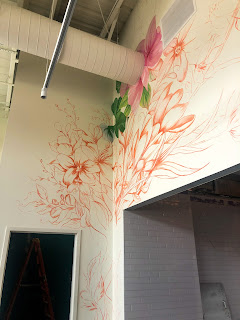harmony."
—Gino Severini
When I first saw the space, it was just a cavernous room full of construction materials. The next time I visited, the interior walls, the kitchen, and bar area were in place. At that time, the vision for the finished space was described to me to provide direction for the mural I would create. The expanse of white wall that would be my blank canvas stretched out above me, a focal point for all who entered. It was reachable only by motorized scissor lift. I was instructed to bring the space to life, to make it vibrant and full of natural energy. Large floral elements were suggested. Next it was time to get to work with my imagination.
Before the painting can begin, I create "sketches" on my Mac using actual images of the space to be painted. These sketches are presented to the client for approval and revision. During this planning phase, I happened to be reading a book called The Book of Ichigo Ichie: The Art of Making the Most of Every Moment, the Japanese Way by Francesc Miralles and Héctor García. It was through this book that I was introduced to the concept of wabi sabi.
I decided that there needed to be a cohesive overarching theme for the mural, not just a scattering of pretty, random flowers. My idea was to depict the seasons, starting with the rebirth and hope inherent in spring, through the lush abundance of summer, to the overripe harvest and natural decay of autumn, transitioning to the quiet rest and gathering of energy in the winter, ending with the return of spring. I was hoping to create a feeling of harmony and natural synergy in the flow of the seasons.
It was important to me to leave blank spaces in the mural. I can't find the quote anywhere, but I was inspired by the idea that blank spaces are actually not empty, but full of potential. These white areas, void of designs, allow the viewer a pause, a space to fill with their own imagination or just to rest their eyes before the next explosion of brilliant, vibrant color - like the space between breaths.
Once the concept sketches were approved, it was time to begin. Starting with the blossoms of spring, I painted the outline of the individual elements with burnt umber paint and then began to fill and shade with brilliant hues.
You can see a time-lapse video of the painting in progress on my YouTube channel here. What you can't see and hear in the video are the loud sounds and constant commotion of the active construction site below me while I worked high above on my scissor lift.
Thank goodness for my earbuds and music to shut out the world and enable focus.
Early on in the painting process, it became clear that people who stopped by liked the sketch elements without embellishment. I was asked if I intended to leave some of the simple red-brown sketch outlines just as they were, without color. It had not been my intention, but I decided to go ahead and give the suggestion a try. It became a true collaboration between artist and onlookers. To some it may look unfinished. To me it suggests the beauty of things incomplete, waiting to emerge, take shape, and blossom.
I worked my way through the delicate blooms of spring to the bare branches, berries, and migrating birds of winter in a couple of weeks. I enjoyed coming to work each day in this beautiful space full of wonderful people fully invested in designing a memorable sensory experience for all who enter.. I am grateful to have been a part of it. I hope you'll stop by Giorgio's Epicurean Market in Raleigh to see for yourself. (Opening late summer/early fall 2024)
More on wabi sabi from " Wabi Sabi: The Japanese Art of Impermanence" by Andrew Juniper...
"Taken from the Japanese words wabi, which translates to less is more, and sabi, which means attentive melancholy, wabi sabi refers to an awareness of the transient nature of earthly things and a corresponding pleasure in the things that bear the mark of this impermanence. As much a state of mind—an awareness of the things around us and an acceptance of our surroundings—as it is a design style, wabi sabi begs us to appreciate the pure beauty of life—a chipped vase, a quiet rainy day, the impermanence of all things. Presenting itself as an alternative to today's fast-paced, mass-produced, neon-lighted world, wabi sabi reminds us to slow down and take comfort in the natural beauty around us."
If you enjoyed this post, considering checking out my book, Approaching the Blank Canvas, Real Talk on Fear, Inspiration and Not Giving Up in Art and Life. It’s full of true tales and tips from my 20+ years of making art for a living. It’s available on Amazon Books and you can also find the link to it and my other books on my DesignsbyArianne website.
If you enjoyed this post, considering checking out my book, Approaching the Blank Canvas, Real Talk on Fear, Inspiration and Not Giving Up in Art and Life. It’s full of true tales and tips from my 20+ years of making art for a living. It’s available on Amazon Books and you can also find the link to it and my other books on my DesignsbyArianne website.











No comments:
Post a Comment